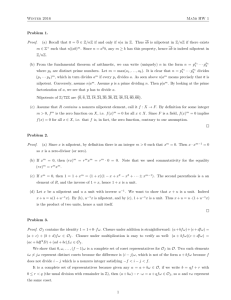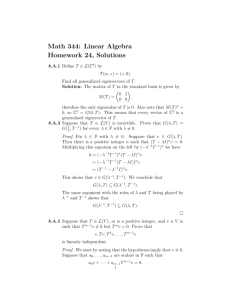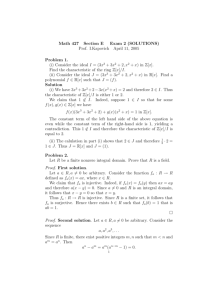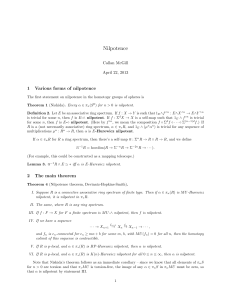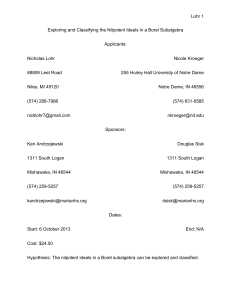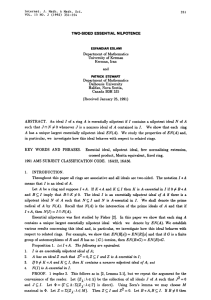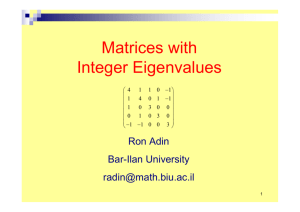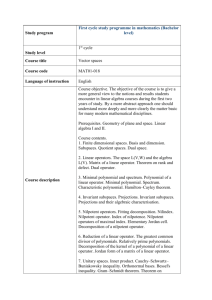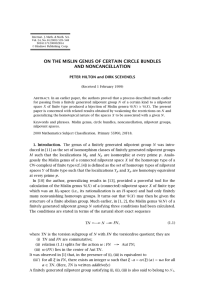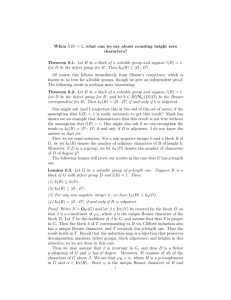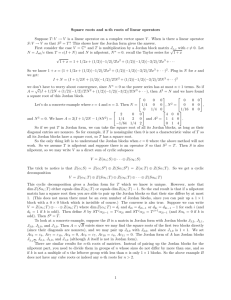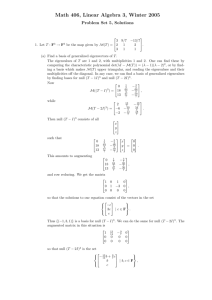Solutions to Homework 6 31. (Dummit
advertisement
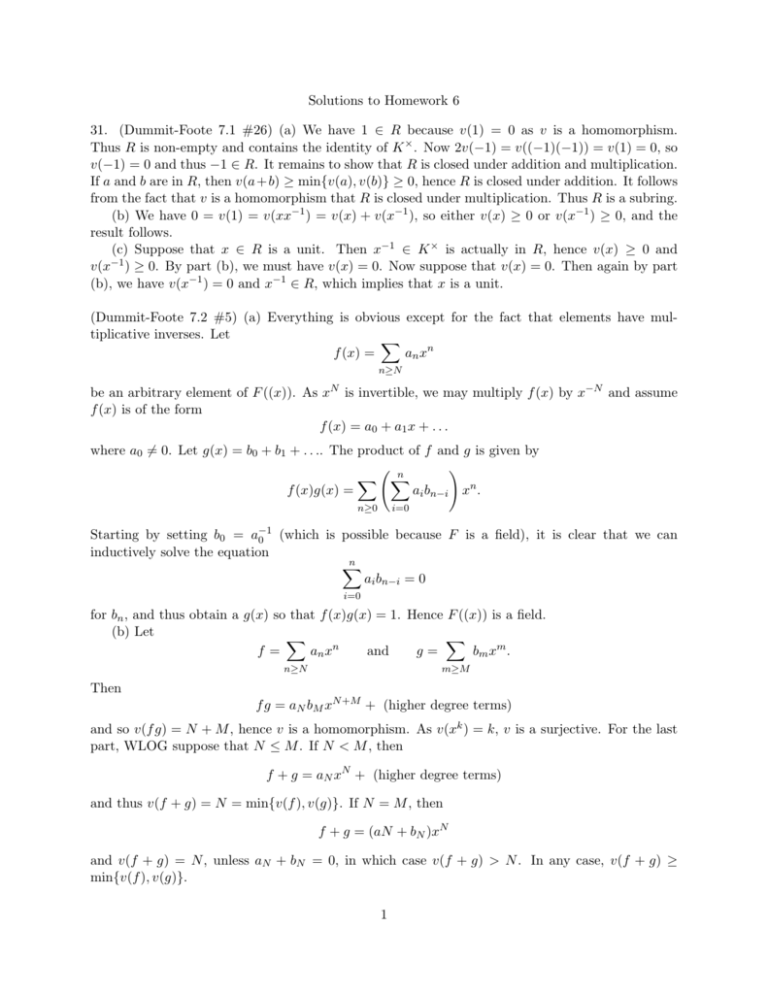
Solutions to Homework 6
31. (Dummit-Foote 7.1 #26) (a) We have 1 ∈ R because v(1) = 0 as v is a homomorphism.
Thus R is non-empty and contains the identity of K × . Now 2v(−1) = v((−1)(−1)) = v(1) = 0, so
v(−1) = 0 and thus −1 ∈ R. It remains to show that R is closed under addition and multiplication.
If a and b are in R, then v(a + b) ≥ min{v(a), v(b)} ≥ 0, hence R is closed under addition. It follows
from the fact that v is a homomorphism that R is closed under multiplication. Thus R is a subring.
(b) We have 0 = v(1) = v(xx−1 ) = v(x) + v(x−1 ), so either v(x) ≥ 0 or v(x−1 ) ≥ 0, and the
result follows.
(c) Suppose that x ∈ R is a unit. Then x−1 ∈ K × is actually in R, hence v(x) ≥ 0 and
−1
v(x ) ≥ 0. By part (b), we must have v(x) = 0. Now suppose that v(x) = 0. Then again by part
(b), we have v(x−1 ) = 0 and x−1 ∈ R, which implies that x is a unit.
(Dummit-Foote 7.2 #5) (a) Everything is obvious except for the fact that elements have multiplicative inverses. Let
X
an xn
f (x) =
n≥N
be an arbitrary element of F ((x)). As xN is invertible, we may multiply f (x) by x−N and assume
f (x) is of the form
f (x) = a0 + a1 x + . . .
where a0 6= 0. Let g(x) = b0 + b1 + . . .. The product of f and g is given by
!
n
X X
f (x)g(x) =
ai bn−i xn .
i=0
n≥0
(which is possible because F is a field), it is clear that we can
Starting by setting b0 = a−1
0
inductively solve the equation
n
X
ai bn−i = 0
i=0
for bn , and thus obtain a g(x) so that f (x)g(x) = 1. Hence F ((x)) is a field.
(b) Let
X
X
f=
an xn
and
g=
bm xm .
n≥N
m≥M
Then
f g = aN bM xN +M + (higher degree terms)
and so v(f g) = N + M , hence v is a homomorphism. As v(xk ) = k, v is a surjective. For the last
part, WLOG suppose that N ≤ M . If N < M , then
f + g = aN xN + (higher degree terms)
and thus v(f + g) = N = min{v(f ), v(g)}. If N = M , then
f + g = (aN + bN )xN
and v(f + g) = N , unless aN + bN = 0, in which case v(f + g) > N . In any case, v(f + g) ≥
min{v(f ), v(g)}.
1
32. (Dummit-Foote 7.1 #27) If a/b ∈ Q× , write a/b = pα c/d, where p divides neither c nor d. Then
vp (a/b) = vp (pα c/d) ≥ 0 if and only if α ≥ 0 if and only if p does not divide the denominator of
(pα c)/d. The units of the valuation ring are all rational numbers whose numerator and denominator
are both relatively prime to p (assuming, of course, that the rational number is in lowest terms).
33. (Dummit-Foote 7.2 #2) Let p(x) = an xn + . . . + a0 be a zero-divisor of R[x], such that
p(x)g(x) = 0, where g(x) = bm xm + . . . + b0 is of minimal degree. Writing out p(x)g(x) immediately
yields an bm = 0. Still following the book’s hint, we have an g(x)p(x) = 0, but since an kills
the leading coefficient of g(x), we must have that an g(x) is of degree smaller than g(x), unless
an g(x) = 0.
Now suppose that an g(x) = an−1 g(x) = · · · = an−i g(x) = 0. We have
0 = p(x)g(x)
= an g(x)xn + . . . + an−i g(x)xn−i + an−i−1 g(x)xn−i−1 + . . . + a0 g(x)
= an−i−1 g(x)xn−i−1 + . . . + a0 g(x)
The leading coefficient of the above polynomial is an−i−1 bm = 0. Thus an−i−1 g(x)p(x) = 0, as
before. By induction, we conclude that ai g(x) = 0 for all i = 0, . . . , n. In particular, ai bm = 0 for
all i, which implies that bm g(x) = 0.
(Dummit-Foote 7.3 #33) For this problem, we can assume the results of exercise 14 of section 1. In
particular, the sum of nilpotent elements is nilpotent, and the sum of a unit and a nilpotent is a unit
(use the binomial theorem to prove the first one, and the formula (xn −1)(x−1) = 1+x+. . .+xn−1
to prove the second).
(a) Suppose that a0 is a unit and that the other ai are all nilpotent. Then clearly ai xi is nilpotent,
so a1 x + . . . + an xn is nilpotent. As a0 is a unit, it follows that p(x) = a0 + a1 x + . . . + an xn is a
unit.
Conversely, suppose that p(x) is a unit. Then we can find some g(x) = b0 + . . . + bm xm such
that p(x)g(x) = 1. This immediately implies that a0 is a unit, the hard part is proving the other
ai are nilpotent. The equation p(x)g(x) = 1 implies that
0 = an bm
0 = an bm−1 + an−1 bm
..
.
0 = an b0 + an−1 b1 + . . . + a0 bn
(set bj = 0 if j > m)
Multiplying the second equation from the top by an gives 0 = a2n bm−1 . Multiplying the third
equation by a2n gives a3n bm−2 = 0. Continuing in this fashion, we see that there is some power ajn
of an we can multiply the last equation by to obtain
0 = aj+1
n b0 .
Multiplying both sides of this equation by b−1
0 (which exists) shows that an is nilpotent.
2
Now an xn is nilpotent, hence p(x) − an xn , the sum of a unit and a nilpotent element, is a unit.
But p(x) − an xn has degree less than that of p(x), so we are done by induction on the degree of
p(x) (the degree zero case being trivial).
(To give credit where credit is due: the above proof is essentially the solution given by Allen
Gehret and Greg Laun.)
(b) If all of the coefficients of p(x) are nilpotent, then p(x) is nilpotent as it is the sum of
nm = 0, hence a xn
nilpotents. For the converse, note that p(x)m = 0 for some m implies that am
n
nx
is nilpotent. Thus p(x) − an xn is the sum of nilpotent elements and hence nilpotent, the result now
follows by induction on the degree of p(x) (the degree zero case being again trivial).
3
